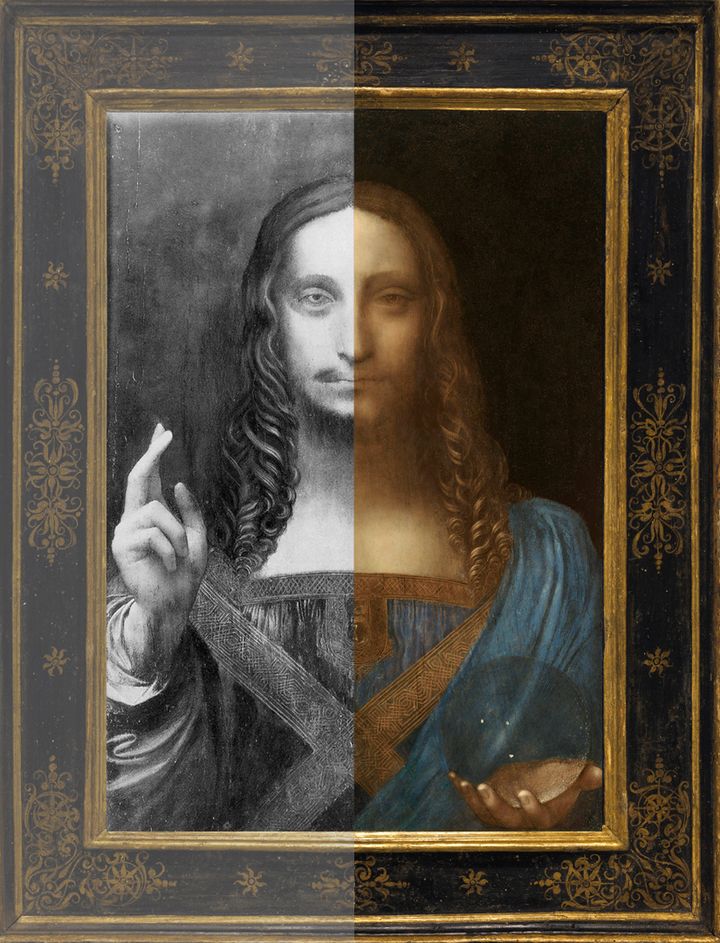
By John Sims
On November 15, 2017, Salvator Mundi (Savior of the World) by Leonardo Da Vinci sold for $450.3 million at Christie’s Auction House in New York, shattering all previous records. This painting depicts a Christ figure with a raised hand in a blessing position and the other hand is holding a glass transparent Orb representing the world. The long time missing painting dates back to the 1500’s. And now the painting's value has increased from 45 pounds to 450 millions dollars in less than 60 years as reported by Artnet.com. If we were to graph the timeline of this painting and its off-the-charts escalating values, we would need to plot it on a logarithmic coordinate system to see the whole graph. I am inclined to find the formula that connects these data points and call it, Da Vinci’s Formula of Art Appreciation, a fitting tribute to an art world gone insane.
As a mathematical artist working in the intersection between mathematics and the arts, I am deeply drawn to anything Da Vinci—his drawings, paintings, dairies, inventions, mathematics, optics, botany, geology, anatomy, literature and most importantly, his mind. His visual art works, The Last Supper, Vitruvian Man and The Mona Lisa, are the most popular images on the planet and too, probably the most valuable. Leonardo Da Vinci is the embodiment of Renaissance genius and the standard of the artist functioning at the highest level.

John Sims in France visiting Leonardo da Vinci
Last year, I visited Leonardo da Vinci’s grave at the Royal Chateau d’Amboise in Loire Valley in France, a grand opportunity to pay my respects to a true polymath. It was indeed special to be in the resting place of Da Vinci, a man who inspired the minds of millions. Standing there, I was reminded of the time when I walked around Bethlehem, the birthplace of Jesus, the man-god who inspired the heart of a civilization. Like millions worldwide, I wondered why I too, was so fascinated with this great artist and thinker. What I admired most about Da Vinci was his attention to detail, penetrating curiosity, lifestyle, personality, and the patronage that maximized his journey of inquiry across boundaries of human knowledge. Also I admired Da Vinci’s ownership of his creative time and his confidence or maybe promiscuous tendency to leave projects unfinished while in pursuit of new ideas, embracing the freedom of creativity and treasures of discovery. His mastery and respect for the elegant blurriness of the edges where light has space and time to reflect in ways that convey sparkles of emotional messages nested so comfortably in familiar places, as magically executed in the smile of Mona Lisa. Although the artist did fewer than 20 paintings, what he did do, is centered in the canon of human art, and speaks to the power and relevance of the quality of discovery and innovation over the quantity of the status quo.

Salvator Mundi: Before (B&W Photo) and After Restoration
But this Salvator Mundi work, with its spectacular growth in value, is all the more interesting considering its provenance is not without question. While some leading experts defend the work as an original Da Vinci, others are a bit more suspicious. Many of the questions are related to the dynamics of the work, the amounts over-painting present, restoration required and the transparent Orb which lacks crucial evidence of the physics of light passing through a glass sphere.
Walter Isaacson, a professor of history at Tulane University and author of “Leonardo Da Vinci” offers, in his recent Washington Post opinion piece, why the painting is valued so highly:
Part of the answer, I believe, is evidenced in “Salvator Mundi” (“Savior of the World”): his ability to connect science and art. He was interested in everything that could possibly be known about creation, including how we fit into it. With a passion that was both playful and obsessive, he pursued studies of anatomy, geology, math, engineering, water flows, architecture, theater, optics and dozens of other disciplines. In so doing, he was able to see the patterns that were woven into what he called “the infinite works of nature.”
I can buy into some of this - there is no doubt that Da Vinci had an incredible mind, and used the fullest extent of his brain; however, this does not address the quizzical orb issue. Professor Isaacson then goes on to the explain why the orb in the painting is transparent.
Why did Leonardo not show the orb producing any distortion? One explanation is that he had not noticed how light is defracted in a solid sphere. That’s wrong. He was, at the time, deep into his optics studies, and the ways light reflected and refracted was an obsession. Scores of his notebook pages are filled with diagrams of light bouncing around at different angles.
Another explanation, more plausible, is that he knew the orb would distort, but he chose not to paint it that way because he thought it would be a distraction. It would indeed have looked weird. But I prefer a third explanation: I think that he knew how the orb would distort and that some of his more sophisticated viewers would also know, but what he is doing in his portrayal of Christ as savior of the world is trying to convey the miraculous quality of his stewardship, that nothing he touches is distorted.
I find it very difficult to accept that Da Vinci would suspend the physics of optics to pay homage to the divinity of Jesus, when his father, God, supposedly gave us the intelligence to figure these things out. Also following this strange logic, why isn’t The Last Supper painted flat rather than in perspective to show the space time light bending magic of Jesus right before he reveals his impending betrayal? I thought the Salvator Mundi painting was worth so much precisely because Da Vinci was able to connect science and art, not because of his disconnection of the two. This seems a bit shady. I would hope that this is not a collusive attempt to promote and protect the power and brand of europeanized notions of creative genius and Christianity, as de facto examples of white cultural and western economic supremacy.
New York magazine art critic Jerry Saltz, in this responding piece in Vulture, is less supportive and posits that the painting is a fake all together. He writes:
I’m no art historian or any kind of expert in old masters. But I’ve looked at art for almost 50 years and one look at this painting tells me it’s no Leonardo. The painting is absolutely dead. Its surface is inert, varnished, lurid, scrubbed over, and repainted so many times that it looks simultaneously new and old. This explains why Christie’s pitches it with vague terms like “mysterious,” filled with “aura,” and something that “could go viral.” Go viral? As a poster, maybe. A two-dimensional ersatz dashboard Jesus.
Saltz goes further to reduce the extravagant auction to a farce:
This kind of salesmanship is an old game: pure and simple greed, an irresponsible knowing flimflam that defrauds a mass audience into thinking it is “appreciating” an old master when it’s all smoky spectacle and mirrors.
Aside from debates about the authenticity of this painting and suspicious art market forces, there seems to be bigger issues at hand. Also as a political artist, engaged seriously in the interrogation of the iconography of white supremacy, I am compelled to ask what are the deeper meanings and messages of this record breaking painting as it relates to the whitening of Jesus and the politics and culture of white supremacy. And how does art market shape cultural supremacy both naturally and artificially. I am convinced Jesus himself would have interrupted that Christie’s auction the way he did with the money changers in the Bible 2000 years ago. And I am sure Da Vinci would be less interested in this painting and more excited by the visual mathematics of the economics that followed this painting from the royal courts of Europe in the 1500’s to the Louvre Abu Dhabi in 2017, courtesy of the new owner, Abu Dhabi Department of Culture and Tourism.
What is more mind boggling than a painting selling for nearly half a billion dollars? Perhaps a trillion-dollar Christmas Holiday economy. Christmas day, the symbolic birthday of Christ has now become a superfluous commercialized ritual of hyper-consumption, corporate exploitation, greed, debt, fake charity, and Santa Claus: completely oppositional to the life and teachings of Jesus Christ. And when you add in mega churches and pimpish ministers; the perversion and monetization of the sacred religious theme seems to have no moral bounds. I am convinced the first thing Jesus is going to do upon his return is to find Santa Claus and give him a nice long public crucifixion.
The resurrection of Salvator Mundi, and the institution of Christmas shopping, should remind us how culture and truth are at the mercy of the mega-wealthy and vested gatekeepers who shape and sometimes subvert the language, meaning and value of our most precious cultural elements for the sake of profit and cultural security, leaving us very often detracted with fairytales of the likes of Santa Claus and transparent Orbs.
So with this in mind, this painting, authentic or not, affirms in very powerful ways that the “blessing” of big business Santa Claus and all of the things like it are bigger than Da Vinci, bigger than Jesus Christ and fast becoming a pathological self-destructive feature of capitalism. My hope that this level of consumption, greed and performative marketing strategies do not lead to permanent damage to the main elements of our humanity, and that we find ways to connect to the genius of our collective full brain intelligence, and stories of our spiritual salvation outside of the super nova gravity of the global market forces.
Merry Holidays and a Happy New Year.!
Follow John Sims on Twitter: @johnsimsproject
